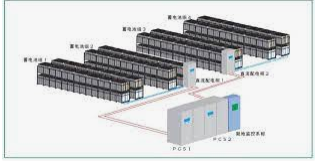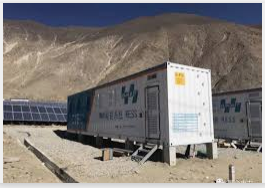In the past few years, the new energy industry has undoubtedly been the hottest track.
We have witnessed the high growth of the industry brought about by “unlimited scenery”. Many stocks with 10 times, 20 times, or even 30 times increase have been born in the stock market. Entering 2022, photovoltaic and wind power will continue to gain momentum. The slope of new energy is long and the snow is thick, and there is no shortage of newcomers. This year’s representative is energy storage.
How hot is energy storage?
According to incomplete statistics from International Energy Network/Energy Storage Headlines, since the beginning of this year, hundreds of new energy storage-related companies have been established, with a registered amount of 42.3 billion yuan. Among them are 43 energy storage technical services, 54 battery and 7 pumped storage new companies. According to incomplete statistics, there are more than 20 listed companies cross-border energy storage.

Meanwhile, energy storage projects have mushroomed.
According to the latest data from Caitongdian, Heiying Photovoltaic has collected information on more than 900 energy storage projects since 2022.
These include: 195 energy storage filing projects in 2022; 142 proposed energy storage projects under construction in 2022; 75 energy storage projects in operation in 2022; 498 energy storage project bidding in 2022.
So, why is energy storage so popular? In short, in the huge market of new energy power generation, energy storage is irreplaceable. The N modes of “energy storage +” deepen the application scenarios, and the future growth space is a sea of stars.
Wind power and photovoltaic power generation are the most core technologies on the road to realize the dual carbon goals and energy transformation. Under the two-wheel drive of policy and market, it ushered in rapid development. The cumulative installed capacity of wind power generation has reached a considerable scale. Based on this, the proportion of wind power generation has risen rapidly.
On December 16, the National Energy Administration released the national power industry statistics from January to November.
As of the end of November, the country’s cumulative installed power generation capacity was about 2.51 billion kilowatts, a year-on-year increase of 8.1%. Among them, the installed capacity of wind power was about 350.96 million kilowatts, a year-on-year increase of 15.1%; the installed capacity of solar power was about 372.02 million kilowatts, a year-on-year increase of 29.4%.
Wind power generation is 614.5 billion kWh, accounting for about 8% of the total power generation; photovoltaic power generation is 212.5 billion kWh, accounting for about 3% of the total power generation. The future development prospect of wind and solar power generation is certain, and it has both time and space.
The “14th Five-Year Plan for Renewable Energy Development” proposes that the proportion of non-fossil energy consumption will reach about 25% in 2030, and the total installed capacity of wind power and solar power will reach more than 1.2 billion kilowatts in 2030. The capacity is about 723 million kilowatts, and the development space is broad.

It is estimated that by 2030, my country’s wind power, solar power and other new energy power generation installed capacity will surpass coal power and become the largest power source, and the proportion of new energy power generation is expected to exceed 50% by 2060.
According to the International Energy Agency’s “World Energy Outlook 2022” report, the proportion of photovoltaic and wind power generation will increase from 10% in 2021 to 40% in 2030, and even reach 70% in 2050. In addition, it is estimated that by 2030, the annual newly installed photovoltaic capacity will more than quadruple to 650GW.
However, as the proportion of wind power generation continues to increase, problems also follow.
Photovoltaic and wind power generation depend on solar energy and wind power respectively. As the sun rises and sets, photovoltaic power generation is destined to change accordingly. It starts to exert power in the morning, peaks at noon and then falls back, and stops at night as the sun sets. The same is true for wind power generation.
The inherent volatility and intermittency of these forces of nature makes the electrical output erratic. The result is an imbalance between supply and demand, unable to provide sufficient power when power consumption is high, and excess power when power consumption is low.
Secondly, another problem caused by wind power generation is the unstable frequency of power supply, and the fluctuation of frequency is related to the quality of power supply.
Frequency changes will cause changes in motor speed, which will affect product quality at least, and damage machinery and cause accidents at worst. It may affect the electricity consumption of ordinary life and even endanger industrial production.
With the increase of the penetration rate of new energy sources, the frequency fluctuations caused by power disturbances to the power grid increase. From April to May 2021, the North China Power Grid experienced low-frequency oscillations on the power side for four consecutive times. At present, the number of primary frequency regulation of conventional thermal power has increased from 20-30 times a day to 700-800 times a day. Traditionally, the primary frequency regulation capability of the thermal power unit itself is insufficient to meet the frequency regulation needs of the power grid.
Therefore, eliminating the instability caused by wind power generation is an urgent problem to be solved.
In this context, energy storage has undoubtedly grasped the pain points of demand for new energy power generation and entered the stage of history.
On the one hand, through peak shaving and valley filling, the problem of mismatch between power generation and power load during peak and valley periods can be solved; on the other hand, it can participate in the provision of power auxiliary services to solve the grid instability caused by the volatility and randomness of wind and solar power generation .

In addition, the storage and release of energy through the energy storage system provides additional capacity support, absorbing excess power, reducing “abandoned wind and light” and instant grid connection.
Energy storage, as the core technology to solve the instability of wind and solar power generation, has ushered in an opportunity for rapid development.






